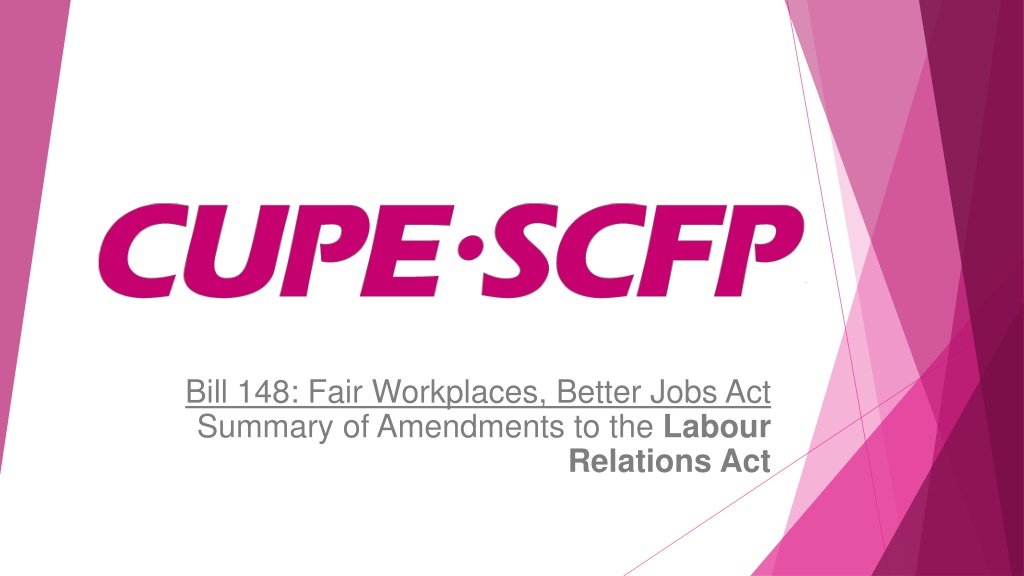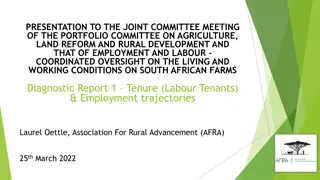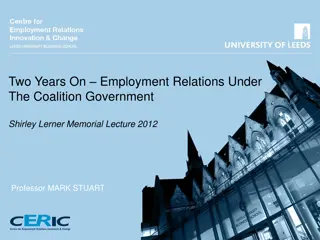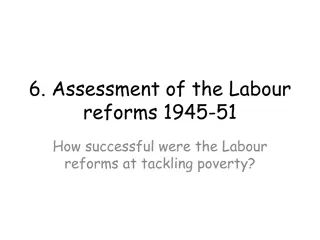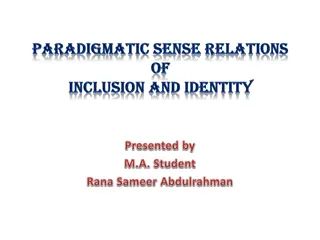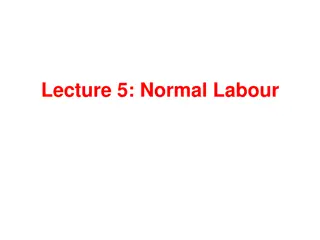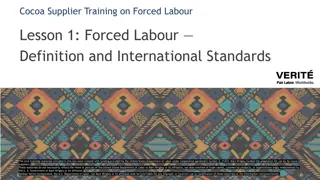Changes in Labour Relations Act Under Bill 148: Summary
The amendments under Bill 148 bring significant changes to the Labour Relations Act, impacting bargaining units, arbitration processes, successor rights, and miscellaneous issues. Key changes include intensive mediation before arbitration for first contract disputes, limits on displacement and decertification, OLRB authority to consolidate bargaining units, extension of successor rights to building services industry, and elimination of the 6-month time period for striking employees. These changes aim to enhance workplace fairness and improve job conditions, effective from January 1, 2018.
Download Presentation

Please find below an Image/Link to download the presentation.
The content on the website is provided AS IS for your information and personal use only. It may not be sold, licensed, or shared on other websites without obtaining consent from the author. Download presentation by click this link. If you encounter any issues during the download, it is possible that the publisher has removed the file from their server.
E N D
Presentation Transcript
Bill 148: Fair Workplaces, Better Jobs Act Summary of Amendments to the Labour Relations Act
Newly Certified Bargaining Units (1) First Contract Arbitration: Intensive mediation before seeking arbitration for all first contract disputes (involving remedial certification or not). If the union was remedially certified, the OLRB must order mediation-arbitration unless the union refused to bargain, bargained in bad faith, or took an uncompromising position. In all other first agreement situations, the OLRB may grant the request, dismiss the application (limited grounds), or order the parties to engage in further mediation. Effective January 1, 2018 2
Newly Certified Bargaining Units (2) Displacement and Decertification: It is now more challenging to decertify a unit as priority is given to mediation and arbitration proceedings over any displacement or decertification application, even if it was brought before the intensive mediation process was triggered. Just Cause protection will cover the period between certification and first CA as well as between a legal strike/lockout and new CA (or when the union loses bargaining rights) Effective January 1, 2018 3
Structure of Bargaining Units Previous: OLRB does not have the authority to revise various bargaining units. The only way in which to change the configuration of bargaining units now is for parties to agree voluntarily to changes. New: Allows the OLRB to consolidate newly certified bargaining units with other existing bargaining units under a single employer, where those units are represented by the same bargaining agent. Note:1st reading version that allowed for different bargaining agents has been removed Effective January 1, 2018 4
Successor Rights Extends successor rights only to the building services industry (e.g., security, food services, and cleaning). Test is whether substantially similar services are subsequently provided at the premises under the direction of another employer . Effective January 1, 2018 5
Miscellaneous Issues Eliminates the 6-month time period for striking employees to make an application to return to work. Some bumping ability for workers wanting to return after strike/lockout. Gives the OLRB a broad power to make any interim order, both procedural or substantive, without legislated tests or restrictions. The OLRB is not required to issue reasons for an interim decision. Fines for violations are increased from $2000 to $5000 (individuals) and $25,000 to $100,000 (organizations). Effective January 1, 2018 6
Bill 148: Fair Workplaces, Better Jobs Act Summary of Amendments to the Employment Standards Act
ESA & Collective Agreements If one or more provisions in an employment contract or in another Act that directly relate to the same subject matter as an employment standard provide a greater benefit to an employee than the employment standard, the provision or provisions in the contract or Act apply and the employment standard does not apply. Employment Standards Act, 2000 Effective January 1, 2018 8
ESA & Collective Agreements There is no acceptable and established methodology to make comparisons of the value to employees of one type of absence compared to another. Such an approach would lead to endless disputes as to whether an employer s leave policies provide greater right or benefit and to uncertainty with respect to the rights of employees and the obligations of employers. Where a company policy does not provide for employees to be absent for the reasons set out in the Employment Standards Act, 2000 s Personal Emergency Leave provisions, notwithstanding the policy of the company, the employee is entitled to additional leaves of absence in accordance with the Personal Emergency Leave provisions of the Employment Standards Act, 2000 . Changing Workplaces Review Effective January 1, 2018 9
Minimum Wage (MW) (1) Increases current general MW of $11.60 to: January 2018: $14.00/hr January 2019: $15.00/hr (after June 2018 election) Tied to CPI thereafter Maintains exemptions (e.g. liquor servers, students under 18 years, home workers, and hunting/fishing guides) with rates increasing by the same percentage as the general minimum wage. Moves MW out of regulations and into legislation as part of the ESA so that any future changes require legislation. Effective January 1, 2018 10
Minimum Wage (2) FAO analysis: Increase will benefit 1.6 million workers (22% of Ontario s workforce) Would also lead to spillover effects that would result in higher wages for workers earning just above the new minimum wage Projected net loss of 50,000 jobs (0.7 % of Ontario s workforce),over short to medium term. However it is important to note that a $15 minimum wage will not mean that 50,000 workers will lose their jobs, but instead a reduction in net jobs can occur either as job losses, a slowdown in employment growth or a reduction in hours worked. 60% of gain in income would flow to bottom half of households Effective January 1, 2018 11
Overtime Pay Previous: Where an employee holds more than one position with an employer, their overtime entitlement is based on a complicated blended rate. New: Simplifies overtime entitlement by requiring overtime pay to be based on the wage rate performed during an overtime period. Effective January 1, 2018 12
Equal Pay for Equal Work (1) Previous: Wage discrimination is allowed except for the prohibition on paying women and men differently for performing substantially the same job. However this has largely been ineffective. New: Replicates the ineffective sex-discrimination scheme and entitles full- time, casual, temporary, and seasonal employees to the same pay rate as regular employees, where they are doing substantially the same job . Grounds to justify differential pay: seniority, merit, quantity or quality of employee production, or other factors . Prohibits Temporary Help Agencies from paying employees a lower wage than that paid to client employees. Grounds to justify differential pay not limited to above; any ground other than sex and employment status may be used. *Effective April 1, 2018* 13
Equal Pay for Equal Work (2) Requires employers to adjust the wages of lower paid employees upwards, where workplace wage rates violate these pay rules. CAs that are inconsistent with these rules will be grandparented if they are in effect as of April 1, 2018. This grandparenting would continue until the earlier of the expiry of the agreement or January 1, 2020. The above provision means that up until Jan 1, 2020 some CA s may stay below the ESA. Unlike most of the other amendments this does not come into force until April 1, 2018 *Effective April 1, 2018* 14
Vacation and Leave Entitlements (1) Previous: Employees are entitled to two weeks of paid vacation (or 4% vacation pay in lieu of vacation). New: Increases paid vacation entitlement to three weeks after five years of service with the same employer with vacation pay increasing to 6% of wages. Makes Family Day a statutory public holiday. Effective January 1, 2018 15
Vacation and Leave Entitlements (2) Previous: Employers are only required to provide 10 days of unpaid personal emergency leave (PEL) per calendar year if they employ 50 or more employees. Covers personal illness, injury or medical emergency or other urgent matter for worker, as well as certain family members New: Eliminates the 50 employee threshold, extending it to all workers First 2 days are paid (must be used first) Can be used as sick days with no medical note required Can also continue to be used for bereavement leave Effective January 1, 2018 16
Vacation and Leave Entitlements (3) Family medical leave would be extended from 8 weeks in a 26-week period to 27 weeks in a 52 week period. Introduces new unpaid leave entitlements for tragedies involving an employee s children (death and disappearance). An employee who has been employed for at least 13 consecutive weeks is entitled to an unpaid leave of absence (10 days & 15 weeks) where that employee or the employee s child experiences domestic or sexual violence or the threat of sexual or domestic violence. The first five days of leave taken (whether taken from the day or week pool) are paid days, while the remainder are unpaid. Syncs unpaid family leave to 2017 Federal EI changes now up to 18 months. Effective January 1, 2018 17
Scheduling Rights (1) Previous: The ESA does not include provisions regulating scheduling of work by employers. The only protection is the 3-hour rule where an employee who regularly works more than 3-hour shifts, and reports to work only to be given less than 3 hours of work, must be paid 3 hours at the minimum wage, or the employee s regular wage for the time worked, whichever is greater. Effective January 1, 2018 18
Scheduling Rights (2) New: Amends current 3-hour rule by paying regular rate of pay, not minimum wage. Where employees are on call (i.e. required to be available for work), and are called into work for less than 3 hours despite being able to work longer, they must be paid three hours at their regular wage. These protections do not apply to workers required to be on call for the purpose of ensuring the continued delivery of essential public services. Provides workers with a right to refuse a shift without repercussion, if given less than 4 days notice unless the cancellation is owing to certain factors beyond an employer s control. Pays 3 hours of wages where employer cancels a scheduled shift with less than 48 hours notice provided cancellation not beyond employer s control. Effective January 1, 2018 19
Scheduling Rights (3) New: Gives employees a statutory right to request changes to their schedule or location without fear of reprisal after 3 months. Where the terms of a collective agreement conflict with the new scheduling provisions, the collective agreement will prevail if the agreement is in effect on January 1, 2019 and the provision ceases to apply upon the expiry of that agreement or January 1, 2020, whichever is earlier. The above provision means that up until Jan 1, 2020 some CAs may stay below the ESA. Effective January 1, 2018 20
Commencement LRA All amendments come into force January 1st, 2018 ESA Most amendments come into force January 1st, 2018 with the following exceptions: Equal pay for equal work rules - April 1, 2018 Act binding on the Crown, right to request shift changes and new scheduling protections January 1, 2019 21
What if you are currently in bargaining? It is important to keep up-to-date with the changes in B148 and understand how it will interact with you CAs. Don t bargain what you already are about to achieve through for free through legislation (e.g. family day). A checklist will be created shortly which will help with the review process. Try to bargaining language that says that at any time there is a conflict between the law and the collective agreement the superior provision prevails. 22
